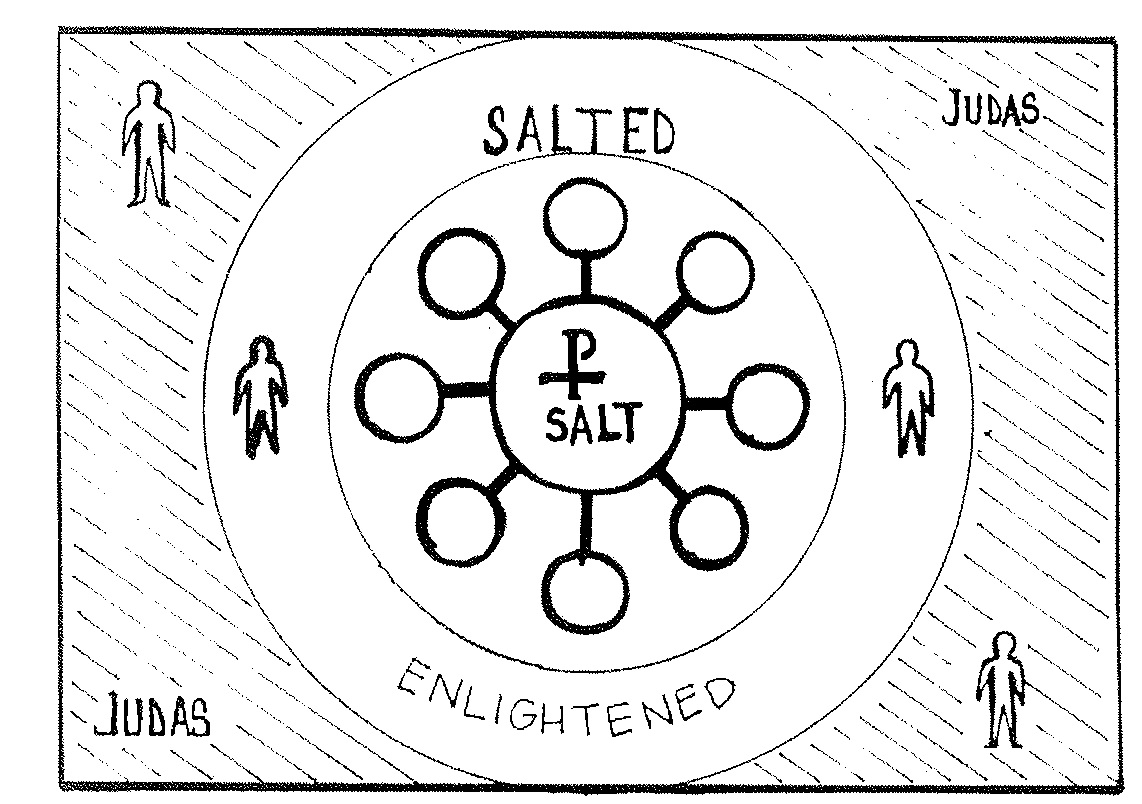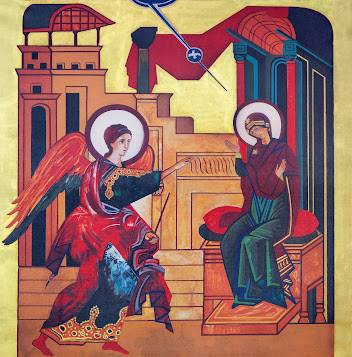In last week's article, we looked at various elements of esoteric Jewish mysticism in the teaching and practice of Kiko Argüello.
That article concluded by commenting on a group of pre-Hasidic Jews, identified by scholars on Jewish mysticism, that claimed to be pneumatic; that is, possessing the Holy Spirit.
The term pneumatic is often found alongside the terms psychic and hylic to refer to three different types of men, according to the philosophy of Gnosticism that was most famously argued against by St. Irenaeus of Lyon, in his landmark work, Adversus Haereses ["Against Heresies"] (Book 1, Chapters 5-8).
St. Irenaeus writes:
They conceive, then, of three kinds of men, spiritual [pneumatic], material [hylic], and animal [psychic]... These three natures are no longer found in one person, but constitute various kinds [of men]. The material goes, as a matter of course, into corruption. The animal, if it make choice of the better part, finds repose in the intermediate place; but if the worse, it too shall pass into destruction. But they assert that the spiritual principles which have been sown by Achamoth, being disciplined and nourished here from that time until now in righteous souls (because when given forth by her they were yet but weak), at last attaining to perfection, shall be given as brides to the angels of the Saviour. (Adv. Haer. I.7.5)
Achamoth, for Gnostics, is a rough parallel of Sophia ("wisdom"), who equates to their heretical conception of the Holy Spirit--a feminine divine aeon, or emanation of God, the bestower of gnosis ("knowledge") and also analogous to the human soul.
So, to put it simply:
- Material, or hylic, men are destined for death and corruption as a matter of course. As the lowest form of man, they can be nothing else.
- Animal, or psychic, men can suffer the same fate as the hylics; or, they can be saved "if they make choice of the better part," which is to say if they follow the instructions and teachings of the enlightened ones.
- Spiritual, or pneumatic, men are the enlightened ones. They have received wisdom (sophia) and knowledge (gnosis) from the Holy Spirit (Achamoth). As long as they continue to be "nourished and disciplined" - that is, progress through the labyrinth of Gnostic secrets - they will "attain perfection" and be saved.
Freemasonry, too, follows a similar pattern. Anyone who is not a Mason is uninitiated, unenlightened. They would fall into the third circle. A little further in, you find the "initiates," the primary degrees of Freemasonry. The Grand Lodge of Ohio says:
The Entered Apprentice degree is a candidate's first experience with the ceremonies of the fraternity... An Entered Apprentice is a learner and, as such, should approach his new vocation with humility and a sincere desire to absorb the lessons of the degree. This includes preparing to devote some time studying and reflecting on the moral and ethical philosophies taught during the ceremony.
These initiates, learners, and students would fall into the second circle. And lastly, again according to the Grand Lodge of Ohio:
...the Master Mason degree symbolizes man's maturity through increased knowledge and wisdom. It is the culmination of all he has learned through the first degrees, incluidng how to prepare for spiritual enlightenment through the craft's teachings.
The Master Masons are in the first circle of the enlightened. Note, however, that even being enlightened and having reached "maturity," he is still only preparing for spiritual enlightenment. Master Mason is only the third degree of Freemasonry out of a possible 33--so there is still much "nourishment and discipline" needed before one can "attain perfection."
Let us now turn to page 78 of the Neocatechumenal Catechetical Directory, Volume 1, where we find this illustration (along with a personal photograph from the catechesis I personally attended, taken on Night 4--exactly when this teaching is prescribed to be taught. A small validation that they do indeed stay on script):


Kiko describes this illustration this way:
How does the Church enlighten, salt and leaven the world?
In the middle we have the living Church made up of adult Christian communities.
A first circle of people are those who are called to form new communities, called to be the Church-sacrament. It is not that they wanted to be the Church but that they have been elected by God to accomplish this mission, this service. (Catechetical Directory for Teams of Catechists, Vol. 1, p. 77)
"Adult Christian communities" and those called to form new "adult Christian communities": in other words, the Neocats. Kiko and his movement are the enlightened ones. They are the "sacramental" Church--the visible sign of the invisible reality. They are God's elect--not because they wanted to be, but because God chose them to be. (Humbling, isn't it?)
There's a second circle formed by people whom God calls to the Church but perhaps only to be related to her without ever coming to belong to her juridically. They are called to know the good news, to be salted and enlightened by the Church on their journey.
...Jesus Christ wants the Church to give a catechesis against that of the world: to enlighten the world...
Jesus wants this community to enlighten people little by little.
These are people who will begin to think after a while: They're not as crazy as I thought they were. How stupid and unjust I have been to criticize them so much.
People think you are earning heaven with great effort. The Church must salt and purify this natural religiosity. The Gospel must be announced to these naturally religious people. Then all these people will enter into dialogue and will be happy to be with the people of the communities...
Perhaps this person, when he is already very near Christianity, will get run over by a car and die. This person dies with Jesus Christ because he has had a Church beside him that helped him and enlightened him by loving and forgiving him. The Church is close to those who suffer, to the poor. (p. 77-79, 81)
The Church, of course, means only the Neocatechumenal Way. You might be a lifelong Catholic, but if you are not walking on the Way, you are not part of the Church. You are part of the "naturally religious" masses and you need the Gospel announced to you by Jesus' anointed ones--Kiko's catechists. But lucky for you, you can still be saved even if you don't ever join up with the Way: you've come to your senses and stopped criticizing them, you've let their communities flourish, and you've shut up and listened. And now, even though you were never "juridically part of the Church" (formally a member of the Way), you can "die with Jesus Christ" because you at least lived your life "Way-adjacent" to let them love and forgive you in your poverty on your way to salvation.
Finally, there is a third circle, a third group of brothers and sisters, those who live a lie, who have always lied to themselves. They are those in whom Satan acts, enslaving them. Not necessarily because they are wicked, or due to any fault of their own, but perhaps for some reason or other that we will not investigate... These people cannot stand the community.
The only way for these brothers and sisters to be saved is for the Church to give her blood for them, the blood of Christians, which is the blood of Jesus Christ. They will kill you and you will give your blood for them, as St. Stephen gave his blood for those who stoned him. In that way, they can all be saved.
p. 82
The outer circle. The least of all men--those necessarily enslaved by Satan, because that slavery isn't even their fault. The one who cannot stand the Neocatechumenal Way must be living a lie and acting on behalf of the devil. And, though they must act on behalf of Satan, they are not necessarily damned. If a Neocat willingly submits to martyrdom, like Stephen, at the hands of one of these "Judases," then he, too, can be saved. [Click here for a deeper treatment of their "Necessary Judas" doctrine.] "The only way anyone would ever oppose you is if the devil is in him, and this person must kill you and you must let him." (Now that wouldn't inculcate a persecution complex in a person at all, would it?)
While certainly not identical, we can nonetheless readily identify some clear similarities between the Gnostics' three circles of men and Kiko's.
In a 2007 General Audience, Pope Benedict XVI affirmed:
Irenaeus refuted the claims of these Gnostics, these intellectuals, from the start. First of all, they possessed no truth superior to that of the ordinary faith, because what they said was not of apostolic origin, it was invented by them. Secondly, truth and salvation are not the privilege or monopoly of the few, but are available to all through the preaching of the Successors of the Apostles, especially the Bishop of Rome.
Much of the same statement can be made of Kiko and the Neocatechumenal Way. They certainly do not possess any truth superior to that of the One True Faith--indeed, they bastardize that truth on nearly every conceivable occasion--nor is anything they teach of apostolic origin. Kiko and Carmen are laypeople, and they will always be laypeople, no matter how many bishops they excoriate and dismiss as "Pharaohs" for not listening to them. The Neocatechumenal Way is not now, nor will it ever be, equivalent to the Catholic Church. At most, it is a "program of adult catechesis" or an "itinerary of Christian initiation," intended by the Church to be one among many. At worst...well, never mind. The Way does not possess a monopoly on salvation, nor is salvation a privilege only members of the Way can receive and bestow to others.
But even at most, why would you choose to follow the Way of Jewish mystics, Gnostics, and Freemasons when the spiritual heritage of Holy Mother Church has so much else to offer?


No comments:
Post a Comment